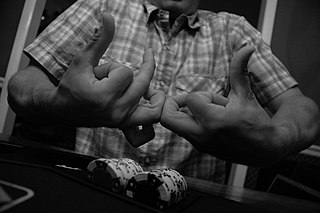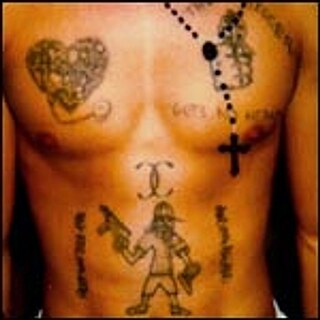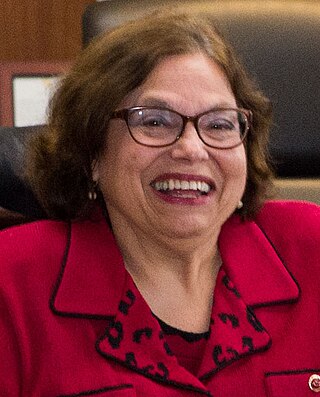
Disability is the experience of any condition that makes it more difficult for a person to do certain activities or have equitable access within a given society. Disabilities may be cognitive, developmental, intellectual, mental, physical, sensory, or a combination of multiple factors. Disabilities can be present from birth or can be acquired during a person's lifetime. Historically, disabilities have only been recognized based on a narrow set of criteria—however, disabilities are not binary and can be present in unique characteristics depending on the individual. A disability may be readily visible, or invisible in nature.

The Bloods are a primarily African-American street gang founded in Los Angeles, California. The gang is widely known for its rivalry with the Crips. It is identified by the red color worn by its members and by particular gang symbols, including distinctive hand signs.
The disability rights movement is a global social movement that seeks to secure equal opportunities and equal rights for all people with disabilities.
Disability studies is an academic discipline that examines the meaning, nature, and consequences of disability. Initially, the field focused on the division between "impairment" and "disability", where impairment was an impairment of an individual's mind or body, while disability was considered a social construct. This premise gave rise to two distinct models of disability: the social and medical models of disability. In 1999 the social model was universally accepted as the model preferred by the field. However, in recent years, the division between the social and medical models has been challenged. Additionally, there has been an increased focus on interdisciplinary research. For example, recent investigations suggest using "cross-sectional markers of stratification" may help provide new insights on the non-random distribution of risk factors capable of acerbating disablement processes.
Independent living (IL), as seen by its advocates, is a philosophy, a way of looking at society and disability, and a worldwide movement of disabled people working for equal opportunities, self-determination, and self-respect. In the context of eldercare, independent living is seen as a step in the continuum of care, with assisted living being the next step.
ADAPT is a United States grassroots disability rights organization with chapters in 30 states and Washington, D.C.

The Crips are an alliance of street gangs that is based in the coastal regions of Southern California. Founded in Los Angeles, California, in 1969, mainly by Raymond Washington and Stanley Williams, the Crips began as an alliance between two autonomous gangs, and developed into a loosely connected network of individual "sets", often engaged in open warfare with one another. Its members have traditionally worn blue clothing since around 1973.

In linguistics, reappropriation, reclamation, or resignification is the cultural process by which a group reclaims words or artifacts that were previously used in a way disparaging of that group. It is a specific form of a semantic change. Linguistic reclamation can have wider implications in the fields of discourse and has been described in terms of personal or sociopolitical empowerment.

Judith Ellen "Judy" Heumann was an American disability rights activist, known as the "Mother of the Disability Rights Movement". She was recognized internationally as a leader in the disability community. Heumann was a lifelong civil rights advocate for people with disabilities. Her work with governments and non-governmental organizations (NGOs), non-profits, and various other disability interest groups, produced significant contributions since the 1970s to the development of human rights legislation and policies benefiting children and adults with disabilities. Through her work in the World Bank and the State Department, Heumann led the mainstreaming of disability rights into international development. Her contributions extended the international reach of the independent living movement.
The depiction of disability in the media plays a major role in molding the public perception of disability. Perceptions portrayed in the media directly influence the way people with disabilities are treated in current society. "[Media platforms] have been cited as a key site for the reinforcement of negative images and ideas in regard to people with disabilities."
Ableism is discrimination and social prejudice against people with physical or mental disabilities. Ableism characterizes people as they are defined by their disabilities and it also classifies disabled people as people who are inferior to non-disabled people. On this basis, people are assigned or denied certain perceived abilities, skills, or character orientations.
Disability culture is a widely used concept developed in the late 1980s to capture differences in lifestyle that are caused or promoted by disability. Disability cultures exist as communities of people around topics of disability. The cultures include arts movements, coalitions, and include but are not limited to: poetry, dance, performance pieces, installments, and sculptures. Steven Brown, in an academic study, wrote, "The existence of a disability culture is a relatively new and contested idea. Not surprising, perhaps, for a group that has long been described with terms like 'in-valid', 'impaired', 'limited', 'crippled', and so forth. Scholars would be hard-pressed to discover terms of hope, endearment or ability associated with people with disabilities." Deaf culture has an older history, having been described in 1965, and Deaf culture can be connected to the larger disability culture, both due to deafness being viewed by others as a disability, and many deaf people being both Deaf and disabled in other ways, which is known as being Deaf plus.

Inspiration porn is the portrayal of people with disabilities as being inspirational to able-bodied people, on the basis of their life circumstances. The term "inspiration porn" is by analogy with pornography, in that the material is perceived as objectifying disabled people for the benefit or gratification of the able-bodied. Inspiration porn may be seen as a form of ableism. An example of inspiration porn might be photo of a child with a disability taking part in an ordinary activity, with captions targeted towards able-bodied people such as "your excuse is invalid", "before you quit, try" or "they didn't let their disability stop them".
Disability justice is a social justice movement which focuses on examining disability and ableism as they relate to other forms of oppression and identity such as race, class and gender. It was developed in 2005 by the Disability Justice Collective, a group including Patty Berne, Mia Mingus, Stacey Milbern, Leroy F. Moore Jr., and Eli Clare. In disability justice, disability is not considered to be defined in "white terms, or male terms, or straight terms." The movement also believes that ableism makes other forms of prejudice possible and that systems of oppression are intertwined. The disability justice framework is being applied to a intersectional reexamination of a wide range of disability, human rights, and justice movements.
Crip, slang for cripple, is a term in the process of being reclaimed by disabled people. Wright State University suggests that the current community definition of crip includes people who experience any form of disability, such as one or more impairments with physical, mental, learning, and sensory, though the term primarily targets physical and mobility impairment. People might identify as a crip for many reasons. Some of these reasons are to show pride, to talk about disability rights, or avoid ranking types of disability.
The cripple punk movement, also known as cpunk,crippunk, or cr*pple punk, is a social movement regarding physical disability rights that rejects inspirational portrayals of those with physical disabilities on the sole basis of their physical disability.

Stacey Park Milbern was a Korean-American Disability Justice activist. She helped create the Disability Justice movement and advocated for fair treatment of disabled people.
Eli Clare is an American writer, activist, educator, and speaker. His work focuses on queer, transgender, and disability issues. Clare was one of the first scholars to popularize the bodymind concept.
Andrew Gurza is a Canadian disability awareness consultant and activist, based in Toronto, who focuses on the intersections of disability and sexuality.







